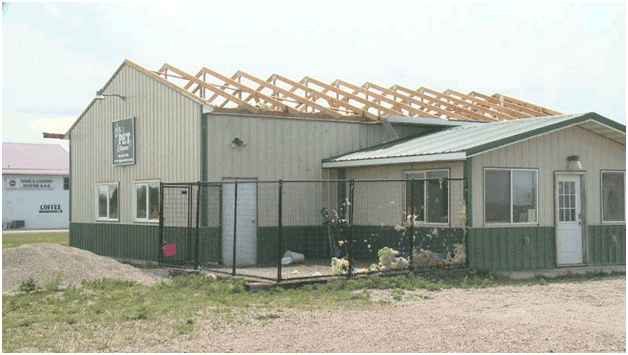No This is NOT a Building Under Construction
Here is the story from the building owner…..
“When we pulled up here, about a quarter to 12 last night, is when I noticed I could see some insulation and then I got out and took a walk around and that’s when I saw that we had no roof,” Joel Hildebrandt said.
Hildebrandt is the co-owner of CJ’s Pet Center in Hawley, Minnesota. During the storm, one of his employees was inside when the damage happened.
“A year’s worth of hard work, not just dollars, and the time,” Hildebrandt said.
Hildebrandt says he’s thankful that no one was hurt.
“Everybody was wet, guests included, but everybody was safe,” Hildebrandt said.
The employee was able to survive the damage by hiding in the bathroom, away from windows.
Something everyone should do when the weather turns ugly.
This building style is what I refer to as a four and eight building – it has columns along the eave sides spaced every eight foot on center, with trusses every four feet supported upon headers (also known as truss carriers).
This is also not a post frame building designed and provided by Hansen Pole Buildings. Our preference is to use a frame system where all of the trusses are doubled and attached directly to the columns. Purlins are attached to trusses with engineered steel hangers manufactured by Simpson Strong Tie (https://www.hansenpolebuildings.com/2013/08/simpson/). We’ve solved the weakest links.
I had addressed a similar structural challenge, in regards to post frame building failures, back in April of 2014: https://www.hansenpolebuildings.com/2014/04/nationwide-2/.
In the case pictured the purlin to truss uplift forces are one-half as much as would this be if trusses were every eight feet.
Still, I have always believed the purlins as fastened typically will not resist the applied uplift loads. The photo proves my point. The roof trusses are intact and still connected to the truss carriers, and the roof steel is still attached to the purlins (just no longer on the building).
When I do an analysis of a failure (or potential failure), I look for the weakest link. More often than not, the weakest link is actually human error.
In the pictured building, the weakest link ended up where I most likely would have guessed it would be.







